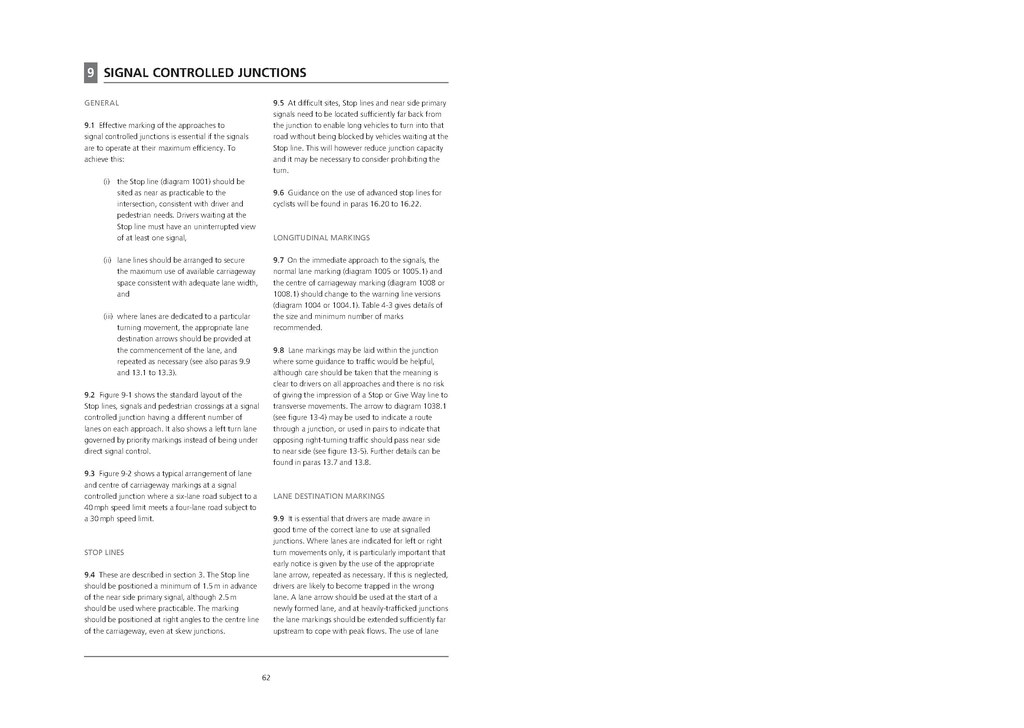9SIGNAL CONTROLLED JUNCTIONS
GENERAL
9.1 Effective marking of the approaches to signal controlled junctions is essential if the signals are to operate at their maximum efficiency. To achieve this:
(i) the Stop line (diagram 1001) should be sited as near as practicable to the intersection, consistent with driver and pedestrian needs. Drivers waiting at the Stop line must have an uninterrupted view of at least one signal,
(ii) lane lines should be arranged to secure the maximum use of available carriageway space consistent with adequate lane width, and
(iii) where lanes are dedicated to a particular turning movement, the appropriate lane destination arrows should be provided at the commencement of the lane, and repeated as necessary (see also paras 9.9 and 13.1 to 13.3).
9.2 Figure 9-1 shows the standard layout of the Stop lines, signals and pedestrian crossings at a signal controlled junction having a different number of lanes on each approach. It also shows a left turn lane governed by priority markings instead of being under direct signal control.
9.3 Figure 9-2 shows a typical arrangement of lane and centre of carriageway markings at a signal controlled junction where a six-lane road subject to a 40 mph speed limit meets a four-lane road subject to a 30 mph speed limit.
STOP LINES
9.4 These are described in section 3. The Stop line should be positioned a minimum of 1.5 m in advance of the near side primary signal, although 2.5 m should be used where practicable. The marking should be positioned at right angles to the centre line of the carriageway, even at skew junctions.
9.5 At difficult sites, Stop lines and near side primary signals need to be located sufficiently far back from the junction to enable long vehicles to turn into that road without being blocked by vehicles waiting at the Stop line. This will however reduce junction capacity and it may be necessary to consider prohibiting the turn.
9.6 Guidance on the use of advanced stop lines for cyclists will be found in paras 16.20 to 16.22.
LONGITUDINAL MARKINGS
9.7 On the immediate approach to the signals, the normal lane marking (diagram 1005 or 1005.1) and the centre of carriageway marking (diagram 1008 or 1008.1) should change to the warning line versions (diagram 1004 or 1004.1). Table 4-3 gives details of the size and minimum number of marks recommended.
9.8 Lane markings may be laid within the junction where some guidance to traffic would be helpful, although care should be taken that the meaning is clear to drivers on all approaches and there is no risk of giving the impression of a Stop or Give Way line to transverse movements. The arrow to diagram 1038.1 (see figure 13-4) may be used to indicate a route through a junction, or used in pairs to indicate that opposing right-turning traffic should pass near side to near side (see figure 13-5). Further details can be found in paras 13.7 and 13.8.
LANE DESTINATION MARKINGS
9.9 It is essential that drivers are made aware in good time of the correct lane to use at signalled junctions. Where lanes are indicated for left or right turn movements only, it is particularly important that early notice is given by the use of the appropriate lane arrow, repeated as necessary. If this is neglected, drivers are likely to become trapped in the wrong lane. A lane arrow should be used at the start of a newly formed lane, and at heavily-trafficked junctions the lane markings should be extended sufficiently far upstream to cope with peak flows. The use of lane
62
